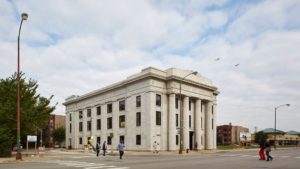Last October, during the first weekend of the Chicago Architecture Biennial, artist and social activist Theaster Gates pulled back the curtain on his latest endeavor: the Stony Island Arts Bank.
The highly trumpeted project entailed the conversion of a derelict bank building on the city’s South Side into a public cultural venue, brimming with galleries, event space and libraries for books, vinyl records and antique slides.
“Artist-led regeneration projects, such as those by Gates, are rare and will likely remain so. But artists can be, and often are, key components of revitalization efforts led by others,” says Storm Cunningham, a community renewal expert and author of The Restoration Economy. “Art is great at bringing diverse citizens together around something they can all appreciate. This is why artists often play a catalytic role, helping spark new ways of seeing a place.”
Stony Island marks the latest in a series of restoration projects by Gates in the low-income neighborhood of Greater Grand Crossing, where tattered buildings and high crime rates prevail. Gates has lived and worked in the community since 2006, making it both his muse and his canvas.
Gates’ unusual approach to merging art, historic preservation and neighborhood redevelopment has made him a singular figure in the cultural world.
“He’s a real estate artist, and there aren’t many figures in contemporary practice whom I could describe in a similar way,” says Jonathan Solomon, head of the architecture department at the School of the Art Institute of Chicago.
He noted that Gates’ restoration efforts aren’t about upping property values and spurring mainstream development. “His work is about knitting communities together, about helping them develop resources and [making] them vibrant, healthy and sustainable,” he said. “I am thrilled his work is in Chicago, and I think it’s amazing for the city that he’s here.”
Moreover, there are countless examples of artists populating blighted, low-rent districts and triggering the emergence of cafés, galleries and other desirable amenities.
See full Interface article by Jenna McKnight + photo credit.


